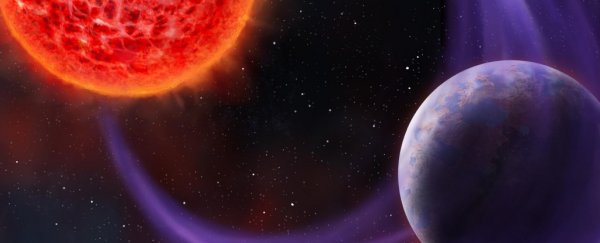A boring, unremarkable star 26 light-years away has turned out to be not so boring after all. Astronomers have found that it has a planet - not just any planet, but one with a mass only about five times Earth's mass - using a wild new method inspired by Jupiter's auroras.
Radio wave activity from the star, called GJ 1151, has been linked to an interaction between the star's magnetic field and an orbiting planet - much like Jupiter's magnetic field is known to interact with the planet's moon, Io.
It's a method that could help us find way more of the hard-to-find rocky exoplanets like Mercury, Venus, Earth, and Mars.
"We adapted the knowledge from decades of radio observations of Jupiter to the case of this star," said astronomer Joe Callingham of the Netherlands Institute for Radio Astronomy (ASTRON).
"A scaled-up version of Jupiter-Io has long been predicted to exist in star-planet systems, and the emission we observed fits the theory very well."
Currently, there are two main ways exoplanets are detected. There's the transit method, like NASA's TESS spacecraft uses. That's when a planet passes between us and its star as it orbits, causing slight dips in the star's light.
Then there's the radial velocity method. This detects the faint wobble in a star's position as it is tugged on by the planet.
But the interaction between Jupiter and Io is interesting. It produces a signature emission in radio wavelengths that are mostly polarised in a circular fashion, and which, in the lower frequencies, can be more powerful than those wavelengths from the Sun.
The Sun's magnetic field isn't strong enough, and the distances are too great, to produce a similar effect from its interaction with the planets in the Solar System, but red dwarfs are different. These very long-lived, small, dim stars have much more powerful magnetic fields than the Sun's, and planets can get much closer.
It was expected that a red dwarf star's close-orbiting planet might produce a similar but more powerful emission than that produced by Jupiter and Io.
"The motion of the planet through a red dwarf's strong magnetic field acts like an electric engine, much in the same way a bicycle dynamo works," explained astronomer Harish Vedantham of ASTRON. "This generates a huge current that powers aurorae and radio emission on the star."
So Vedantham and an international team of astronomers set out to look for circularly polarised low-frequency radio waves. They used data from a survey conducted using LOFAR, a telescope array in the Netherlands that scans the skies in low radio frequencies, and identified several emissions that fit the bill, lining up with red dwarf stars.
One of them was GJ 1151. It was the perfect candidate for further study.
Many red dwarfs, especially those detectable in radio wavelengths, are extremely turbulent, lashing the space around them with stellar flares, rotating extremely fast, and/or interacting with a binary companion.
GJ 1151 rotates extremely slowly - once every 130 days. It's unusually peaceful for a red dwarf. And binary companions can be hidden, so a separate team conducted careful observations using the High Accuracy Radial Velocity Planet Searcher instrument on the Italian Telescopio Nazionale Galileo in Spain.
They detailed their painstaking search and findings in a separate paper, where they rule out other companion stars, brown dwarfs, or giant planets that might also explain the results.
"Interacting binary stars can also emit radio waves," said astronomer Benjamin Pope of New York University.
"Using optical observations to follow up, we searched for evidence of a stellar companion masquerading as an exoplanet in the radio data. We ruled this scenario out very strongly, so we think the most likely possibility is an Earth-sized planet too small to detect with our optical instruments."
That planet's exact mass is still to be determined, but it's likely to be a rocky planet, orbiting the star every one to five days. That's pretty tight, and probably a bit too close to the star to be hospitable.
But it also offers a new way to search for potentially habitable worlds.
In both the transit and radial velocity methods, the effects of the planet's orbits on the star are very, very slight. So the more massive the planet, the more likely we are to detect it. That means most of the exoplanets detected are on the large end of the scale - gas and ice giants, like Jupiter, Saturn, Neptune, and Uranus.
Smaller exoplanets are more elusive. But this amazing new method demonstrates that they can be detected by analysing a star's radio signals. In fact, the team expects "many tens" of such detections will be made based on the remainder of the LOFAR survey data; they're currently working on that research.
In turn, this will help us understand the magnetic field environment of exoplanets, and what that means for the search for alien life.
"The long-term aim is to determine what impact the star's magnetic activity has on an exoplanet's habitability, and radio emissions are a big piece of that puzzle," Vedantham said.
"Our work has shown that this is viable with the new generation of radio telescopes and put us on an exciting path."
The papers have been published in Nature Astronomy and The Astrophysical Journal Letters.
